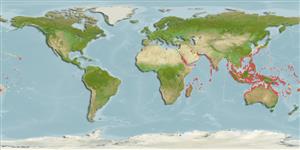Common names from other countries
Environment: milieu / climate zone / depth range / distribution range
Οικολογία
; εύρος βάθους 0 - 46 m (Ref. 75840). Tropical
Indo-Pacific: from East and South Africa, including Madagascar, the Red Sea and the Persian Gulf, to eastern Polynesia; north to Japan and Hawaii, and south to Queensland.
Length at first maturity / Μέγεθος / Βάρος / Age
Maturity: Lm ? range ? - ? cm Max length : 7.5 cm SHL αρσενικό/απροσδιόριστο; (Ref. 348); common length : 5.0 cm SHL αρσενικό/απροσδιόριστο; (Ref. 348)
This is the most common Barbatia species of the Indo-Pacific (Ref. 2922). Attached by byssus among rocks, underside of coral slabs, or nestling in crevices. Littoral and sublittoral (Ref. 348). Also occurs in shallow areas of lagoons where it is attached to dead corals (Ref. 65033). Dead shells found on the beaches (Ref. 88739).
Life cycle and mating behavior
Γεννητική Ωρίμανση | Αναπαραγωγή | Γεννοβολία | Αβγά | Γονιμότητα | Προνύμφες
Members of the class Bivalvia are mostly gonochoric, some are protandric hermaphrodites. Life cycle: Embryos develop into free-swimming trocophore larvae, succeeded by the bivalve veliger, resembling a miniature clam.
Poutiers, J.M. 1998. (Ref. 348)
IUCN Red List Status (Ref. 130435)
CITES status (Ref. 108899)
Not Evaluated
Not Evaluated
Threat to humans
Harmless
Human uses
αλιεία: Εμπορικό(ά)
| FishSource |
Εργαλεία
Περισσότερες πληροφορίες
Age/SizeΑύξησηLength-weightLength-lengthΜορφολογίαΠρονύμφεςΑφθονία
Διαδικτυακές πηγές
Estimates based on models
Preferred temperature
(Ref.
115969): 24.7 - 29.3, mean 28.5 (based on 3234 cells).
Vulnerability
Low vulnerability (10 of 100).
Price category
Unknown.
